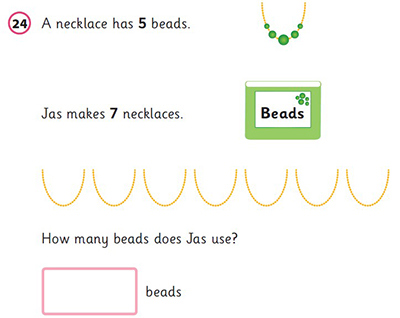How can KS1 pupils use pictorial support for problem-solving questions?
In this Ask the expert, Emily Jones analyses how year 1 pupils use pictorial support to guide them through problem-solving questions in NFER’s year 1 maths assessments.
Diagnostic assessment is a useful way to inform teaching. By using assessment to identify what concepts have been well understood and those that pupils have found more challenging, future lessons can target curriculum areas that need more support. For this reason, NFER has developed diagnostic commentaries for all spring reading and mathematics assessments for years 1-6. These diagnostics are the result of analysing pupil responses from a nationally representative sample that trialled the assessments during development. Included within the teacher guides, these diagnostic commentaries highlight common misconceptions and also provide ways to address these within future learning.
The question below has been taken from NFER’s year 1 spring mathematics assessment; specifically, from the first paper, which provides support to help the pupils calculate their answers to the questions. The second, harder paper does not provide the same level of visual support. In this question, pupils are assessed on their ability to recognise the need for multiplication to solve the problem and their success in doing so. Pupils can use the pictoral support in a variety of ways, including as a concrete indication of how many ‘fives’ to count up in or as an outline on which to draw beads.

What do the results tell us?
Despite the visual aids, this was a hard question: 31% of pupils gave the correct answer of 35. However, beyond right and wrong, we can learn a lot from the incorrect answers given.
One common error was counting elements of the imagery provided with the question. This was done by almost a fifth of pupils, with 10% giving an answer of 5 (counting the beads on the necklace) and 9% giving an answer of 7 (counting the individual necklaces). These pupils have interacted with the question and identified one of the important numbers, but they haven’t recognised that a calculation is required.
Another common mistake was applying the wrong operation. For instance, some pupils gave the answer of 12 – they added the given numbers rather than using multiplication. This error was seen in other similar problem-solving questions.
What can we learn from this?
Our analysis showed that pupils who used pictorial support when it was provided were more likely to find the correct answer than pupils who attempted the question without it. It is therefore worth reminding pupils that writing down their working is more likely to lead to success, especially for problem-solving questions: it helps to order thinking, identify key information and ultimately find the correct answer.
For those pupils already using the support and able to identify the key information, more opportunities to practise identifying the correct operation should be provided. This might come from modelling a variety of solutions such as drawing 5 beads on each of the necklaces, counting up in fives and finally noting that the solution could also be written as 5 x 7. It is worth noting that pupils of different abilities are likely to use different methods, with lower ability pupils more likely to need to draw the beads on each necklace and higher ability pupils being encouraged to use the multiplication notation.
Did you know?
The NFER Tests range includes mathematics assessments for use across years 1-6. These standardised tests provide reliable standardised and age-standardised scores to help you confidently monitor attainment and progress, and are supported by a free online analysis tool. Click here to find out more.
Written by Emily Jones, Research Director at NFER.
Emily has been with NFER since 2001 and has worked on a wide range of projects, centred on developing test materials in science and mathematics, including for the Key Stage 1 and Key Stage 2 statutory tests in England and the Australian statutory NAPLAN test.
Emily is responsible for the development of NFER Tests in mathematics, reading, grammar and punctuation and spelling. She is also a consultant member of the TIMSS (Trends in International Mathematics and Science Study) 2019 Science and Maths Item Review Committee and in recent years has contributed to the development of their new practical science e-assessment tasks, as well as developing and trialling the standard science questions.
Do you have a question on assessment that you’d like to put to one of our assessment team? Send it through to us at [email protected]
